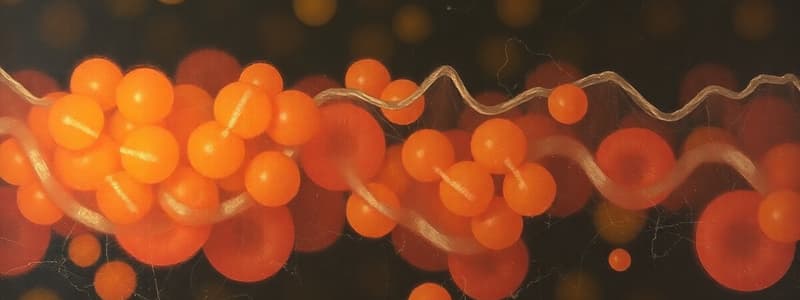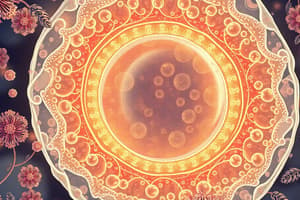Podcast
Questions and Answers
Which characteristic of phospholipids primarily drives their spontaneous arrangement into bilayers in aqueous solutions?
Which characteristic of phospholipids primarily drives their spontaneous arrangement into bilayers in aqueous solutions?
- The ability to form strong covalent bonds with water molecules.
- The amphipathic nature, possessing both hydrophobic and hydrophilic regions. (correct)
- The high concentration of cholesterol molecules within their structure.
- The presence of saturated fatty acid tails that repel water.
A researcher is studying a newly discovered unicellular organism and observes that its cell membrane is highly impermeable to a specific polar molecule. Which component of the membrane is primarily responsible for this impermeability?
A researcher is studying a newly discovered unicellular organism and observes that its cell membrane is highly impermeable to a specific polar molecule. Which component of the membrane is primarily responsible for this impermeability?
- The peripheral proteins embedded within the membrane.
- The cholesterol molecules interspersed among the phospholipids.
- The hydrophobic hydrocarbon chains in the lipid bilayer. (correct)
- The glycoproteins extending from the extracellular surface.
How do integral and peripheral proteins differ in their association with the cell membrane?
How do integral and peripheral proteins differ in their association with the cell membrane?
- Integral proteins primarily function in cell signaling, while peripheral proteins are mainly involved in structural support.
- Integral proteins are found only on the extracellular side, while peripheral proteins are located exclusively on the cytoplasmic side.
- Integral proteins are permanently embedded within the lipid bilayer, while peripheral proteins are only temporarily associated with the membrane surface. (correct)
- Integral proteins are loosely associated with the membrane surface, while peripheral proteins are embedded within the lipid bilayer.
Glycoproteins and glycolipids are exclusively located on the extracellular side of the cell membrane. What is the primary role associated with this specific localization?
Glycoproteins and glycolipids are exclusively located on the extracellular side of the cell membrane. What is the primary role associated with this specific localization?
A scientist introduces a new drug that inhibits the synthesis of cholesterol in cells. How would this drug most likely affect the structure and function of the cell membrane?
A scientist introduces a new drug that inhibits the synthesis of cholesterol in cells. How would this drug most likely affect the structure and function of the cell membrane?
In the fluid mosaic model, which component is responsible for the mosaic arrangement?
In the fluid mosaic model, which component is responsible for the mosaic arrangement?
Which of the following best describes the behavior of amphipathic molecules in an aqueous environment?
Which of the following best describes the behavior of amphipathic molecules in an aqueous environment?
How does the presence of unsaturated fatty acids within the phospholipids affect the fluidity of a cell membrane?
How does the presence of unsaturated fatty acids within the phospholipids affect the fluidity of a cell membrane?
Which of the following is NOT a typical function of membrane proteins?
Which of the following is NOT a typical function of membrane proteins?
A cell needs to import a large amount of a polar molecule. Which mechanism would it most likely use?
A cell needs to import a large amount of a polar molecule. Which mechanism would it most likely use?
If a cell membrane is treated with an enzyme that destroys the carbohydrates present on the outer surface, what function would be most affected?
If a cell membrane is treated with an enzyme that destroys the carbohydrates present on the outer surface, what function would be most affected?
How does cholesterol contribute to the stability of the cell membrane at high temperatures?
How does cholesterol contribute to the stability of the cell membrane at high temperatures?
Which environmental change would likely cause the greatest shift in the composition of fatty acids in a cell membrane?
Which environmental change would likely cause the greatest shift in the composition of fatty acids in a cell membrane?
If a researcher removes all peripheral proteins from a cell membrane, what function is LEAST likely to be affected?
If a researcher removes all peripheral proteins from a cell membrane, what function is LEAST likely to be affected?
How do lipid rafts, specialized microdomains within the cell membrane, differ from the surrounding membrane?
How do lipid rafts, specialized microdomains within the cell membrane, differ from the surrounding membrane?
A cell membrane contains a high proportion of glycolipids. What is the MOST likely function associated with these molecules?
A cell membrane contains a high proportion of glycolipids. What is the MOST likely function associated with these molecules?
Which of these processes is LEAST dependent on the fluidity of the cell membrane?
Which of these processes is LEAST dependent on the fluidity of the cell membrane?
A certain toxin disrupts the interaction between peripheral proteins and the cell membrane. What is the MOST likely mechanism of action of this toxin?
A certain toxin disrupts the interaction between peripheral proteins and the cell membrane. What is the MOST likely mechanism of action of this toxin?
How would a mutation that prevents glycosylation of membrane proteins affect a cell's interactions with its environment?
How would a mutation that prevents glycosylation of membrane proteins affect a cell's interactions with its environment?
A cell is engineered to produce phospholipids with only saturated fatty acids. How would this alteration MOST likely impact the cell's function?
A cell is engineered to produce phospholipids with only saturated fatty acids. How would this alteration MOST likely impact the cell's function?
Flashcards
Amphipathic Lipids
Amphipathic Lipids
Lipids with both hydrophobic and hydrophilic regions which spontaneously form bilayers in water.
Lipid Bilayer
Lipid Bilayer
A sheetlike structure composed of two layers of lipid molecules, primarily phospholipids.
Lipid Bilayer Barrier
Lipid Bilayer Barrier
The lipid bilayer's hydrophobic core restricts passage of large, polar molecules and ions.
Membrane Proteins
Membrane Proteins
Signup and view all the flashcards
Integral Proteins
Integral Proteins
Signup and view all the flashcards
Peripheral Proteins
Peripheral Proteins
Signup and view all the flashcards
Glycoproteins & Glycolipids
Glycoproteins & Glycolipids
Signup and view all the flashcards
Fluid Mosaic Model
Fluid Mosaic Model
Signup and view all the flashcards
Study Notes
- Lipid bilayers form the basis of cell membranes.
- Phospholipids and other amphipathic lipids spontaneously create continuous, sheet-like bilayers in water.
- The hydrophobic hydrocarbon chains at the core of a membrane have low permeability to large molecules and hydrophilic particles.
- Membranes act as effective barriers between aqueous solutions because of the hydrophobic core.
- Membrane proteins have varied structures, locations, and functions.
- Integral proteins are embedded within the lipid layers.
- Peripheral proteins attach to the surface of the bilayer.
- Carbohydrate structures are linked to proteins or lipids in membranes, and located on the extracellular side
- Glycoproteins and glycolipids are involved in cell adhesion and cell recognition.
- The fluid mosaic model includes peripheral and integral proteins, glycoproteins, phospholipids, and cholesterol, with hydrophobic and hydrophilic regions.
- Phospholipid bilayers form due to the presence of hydrophobic and hydrophilic regions.
- Amphipathic molecules contain both hydrophobic and hydrophilic regions.
Studying That Suits You
Use AI to generate personalized quizzes and flashcards to suit your learning preferences.




